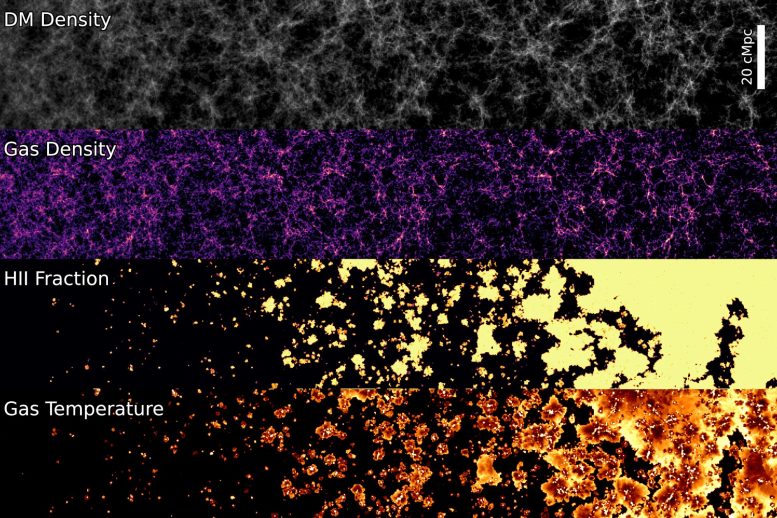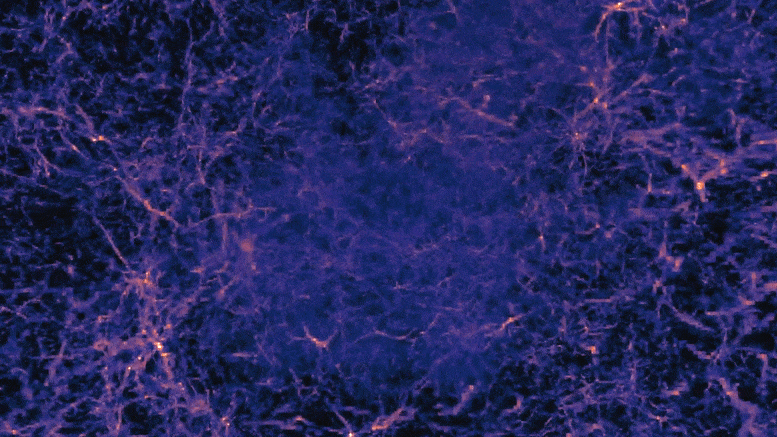A short clip on modeling Tesano. Watch the video in the article below.
Teson’s modeling of the first billion years, named after the goddess of dawn, helps explain how radiation formed the early universe.
It all started about 13.8 billion years ago, from the colossal cosmic “explosion” that suddenly and miraculously created the universe. Soon the baby’s universe cooled dramatically and became completely dark.
Then, a few hundred million years later[{“ attribute=““>Big Bang, the universe woke up, as gravity gathered matter into the first stars and galaxies. Light from these first stars turned the surrounding gas into a hot, ionized plasma — a crucial transformation known as cosmic reionization that propelled the universe into the complex structure that we see today.
Now, scientists can get a detailed view of how the universe may have unfolded during this pivotal period with a new simulation, known as Thesan, developed by scientists at MIT, Harvard University, and the Max Planck Institute for Astrophysics.
Named after the Etruscan goddess of the dawn, Thesan is designed to simulate the “cosmic dawn,” and specifically cosmic reionization, a period which has been challenging to reconstruct, as it involves immensely complicated, chaotic interactions, including those between gravity, gas, and radiation.
The Thesan simulation resolves these interactions with the highest detail and over the largest volume of any previous simulation. It does so by combining a realistic model of galaxy formation with a new algorithm that tracks how light interacts with gas, along with a model for cosmic dust.

Evolution of simulated properties in the main Thesan run. Time progresses from left to right. The dark matter (top panel) collapse in the cosmic web structure, composed of clumps (haloes) connected by filaments, and the gas (second panel from the top) follows, collapsing to create galaxies. These produce ionizing photons that drive cosmic reionization (third panel from the top), heating up the gas in the process (bottom panel). Credit: Courtesy of THESAN Simulations
With Thesan, the researchers can simulate a cubic volume of the universe spanning 300 million light years across. They run the simulation forward in time to track the first appearance and evolution of hundreds of thousands of galaxies within this space, beginning around 400,000 years after the Big Bang, and through the first billion years.
So far, the simulations align with what few observations astronomers have of the early universe. As more observations are made of this period, for instance with the newly launched James Webb Space Telescope, Thesan may help to place such observations in cosmic context.
For now, the simulations are starting to shed light on certain processes, such as how far light can travel in the early universe, and which galaxies were responsible for reionization.
“Thesan acts as a bridge to the early universe,” says Aaron Smith, a NASA Einstein Fellow in MIT’s Kavli Institute for Astrophysics and Space Research. “It is intended to serve as an ideal simulation counterpart for upcoming observational facilities, which are poised to fundamentally alter our understanding of the cosmos.”
Smith and Mark Vogelsberger, associate professor of physics at MIT, Rahul Kannan of the Harvard-Smithsonian Center for Astrophysics, and Enrico Garaldi at Max Planck have introduced the Thesan simulation through three papers, the third published on March 24, 2022, in the Monthly Notices of the Royal Astronomical Society.
Follow the light
In the earliest stages of cosmic reionization, the universe was a dark and homogenous space. For physicists, the cosmic evolution during these early “dark ages” is relatively simple to calculate.
“In principle you could work this out with pen and paper,” Smith says. “But at some point gravity starts to pull and collapse matter together, at first slowly, but then so quickly that calculations become too complicated, and we have to do a full simulation.”
To fully simulate cosmic reionization, the team sought to include as many major ingredients of the early universe as possible. They started off with a successful model of galaxy formation that their groups previously developed, called Illustris-TNG, which has been shown to accurately simulate the properties and populations of evolving galaxies. They then developed a new code to incorporate how the light from galaxies and stars interact with and reionize the surrounding gas — an extremely complex process that other simulations have not been able to accurately reproduce at large scale.
“Thesan follows how the light from these first galaxies interacts with the gas over the first billion years and transforms the universe from neutral to ionized,” Kannan says. “This way, we automatically follow the reionization process as it unfolds.”
Finally, the team included a preliminary model of cosmic dust — another feature that is unique to such simulations of the early universe. This early model aims to describe how tiny grains of material influence the formation of galaxies in the early, sparse universe.
This modeling of gas evolution and radiation shows the embodiment of neutral hydrogen gas. The colors reflect the intensity and brightness, revealing an incomplete reionization structure in a network of high-density neutral gas filaments.
Space Bridge
After the simulation components were installed, the team determined the initial conditions approximately 400,000 years after the Big Bang, based on the exact amount of light remaining from the Big Bang. Using the SuperMUC-NG machine, one of the largest supercomputers in the world, they created these conditions in a timely manner to simulate an expanse of the universe, using 60,000 computer cores simultaneously, equivalent to Teson’s 30 million processors. Per hour (an attempt that would have taken 3,500 years to work on a desktop).
Modeling has created the most comprehensive view of cosmic reionization in the largest space of existing modeling. While some simulations are done over long distances, they are done at relatively low resolutions, while others, more detailed models do not involve larger sizes.
“We are switching between these two methods: we have larger quantities and higher accuracy,” says Vogelsberger.
Early modeling analysis shows that by the end of cosmic reonisation, the distance light could travel significantly increased than previously thought by scientists.
“Theson discovered that light did not travel long distances in the early universe,” says Conan. “In fact, this distance is so small that it will only get bigger at the end of the reconstruction, increasing 10 times in a few hundred million years.
Researchers are also looking for clues as to the type of galaxies responsible for recombination. Although the mass of the galaxy seems to be influencing the recombination, the team says further observations by James Webb and other observatories will help identify these dominant galaxies.
“There are a lot of moving parts [modeling cosmic reionization]”It’s a very rewarding moment for all of us, when we incorporate all of this into some kind of machine and start running it and creating a dynamic universe,” Vogelsberger concludes.
Reference: A. Smith, R. Canon, e. Garaldi, M. Vogelsberger, r. Buckmore, “Another Project: The Inauguration and Broadcasting of Lyman-A during the Rayonization Period,” by Springill & L. Hernquist, 2022. March 24 here. Monthly Reports of the Royal Society of Astronomy.
DOI: 10.1093 / mnras / stac713
The study was partially supported by NASA, the National Science Foundation, and the Gaussian Supercomputer Center.

Prone to fits of apathy. Unable to type with boxing gloves on. Internet advocate. Avid travel enthusiast. Entrepreneur. Music expert.



